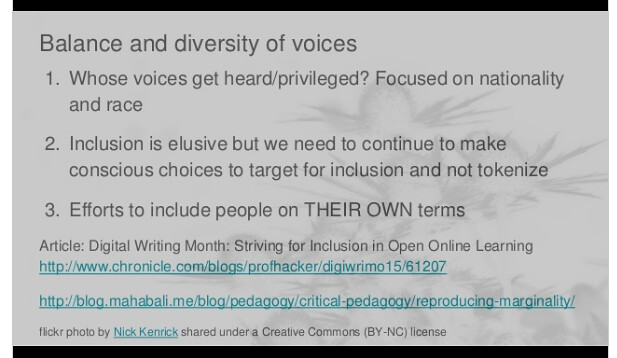
flickr photo shared by levork under a Creative Commons ( BY-SA ) license
I am very fortunate in having connected with so many educators around the globe for the ways their thinking keeps my thinking moving forward. Here’s the perfect example. Last November, I co-facilitated Digital Writing Month with Sarah Honeychurch (Scotland) and Maya Bali (Egypt).
Not too long ago, Sarah presented at the AltC Conference on the nature on the facilitation of open learning networks, turning her attention to Digital Writing Month, Connected Learning MOOC (CLMOOC) and various Rhizomatic Learning activities. (See her presentation slides here). Maha and I added some ideas to the presentation, but Sarah presented.
Sarah’s slides about Inclusion and Exclusion (who gets invited and who gets left out), often articulated beautifully when working with Maha, remains one of those tricky topics that we must keep asking ourselves about. This is also Connected Educator Month (in the US) — this issue of equity and access has to always be front and center. Not just for students (which is always a critical conversation) but also about educators.
We had this kind of conversation this summer, during CLMOOC, when a Twitter Chat conversation suddenly turned on that question of “Who is Here and Who is Not Here,” and my friend Daniel, who works with youth in urban Chicago and often notices the disparity of access, reminds us again and again about reaching out, making deeper connections, offering up invitations.
Avoid the echo chamber. This slide is from Sarah’s presentation:
Often, this is easier said than done, I think. It’s easier to reach out to your existing networks, which may grow … but only incrementally, for the most part. And often, they grow with like-minded people. You speak the same “language” and articulate similar views. There is research that shows that many people remain in their social networking comfort zone.
Maha Bali, who is insightful in her observations of the US-dominated connected education conversations, wisely guided the activities in the invitations for Digital Writing Month. Sarah and I helped Maha to reach out to writers and educators from various places in the world and cultures and backgrounds. What I didn’t realize at the time is that for every invite that fell into the traditional invite (white, male, American, etc.), Maha and Sarah reached out even further for someone else, to balance out the community.
To be honest, it took a lot of time and a lot of effort on the part of us, the facilitators, to make that happen. I’m not sure we were completely successful, but we were successful enough for me to appreciate Maha’s and Sarah’s insistence on the task. The new voices and the new ideas, and the new perspectives and lens on the world, enriched the experience.
I’m not sure we do that enough with CLMOOC, particularly this year when it was a crowdsourced affair. When National Writing Project folks were overseeing CLMOOC, there was more planned intention, I think. This summer, as a crowd of us sought to run CLMOOC, there was probably not enough purposeful invite.
We didn’t do demographic studies, but a casual observation would be that we are mostly white, middle-class, American educators. This is not bad, but it doesn’t reflect the kind of diverse thinking that one would hope for (or at least, what I would hope for) in an open learning environment. We think of open learning as open doors, but some doors remain shut to people for all sorts of reasons.
In the open learning networks that I am part of, none of this exclusion is ever intentional, as far as I can tell. If it was, I would push back or leave. That doesn’t mean the exclusion doesn’t happen, however. It does. And if we want the places where we learn together, and explore ideas together and collaboratively, to be truly “open,” then the issue of inclusion/exclusion has to be on the minds of any facilitator planning such a space.
Efforts must be made.
Peace (in the think),
Kevin


Excellent reflection Kevin and one that’s on my mind these days (ok, ALWAYS, but even more so than usual believe it or not) so thanks for what you have added to the conversation and for focusing on the slides I used on inclusion and exclusion. Would you argue, then, that unless your grassroots team are very cognizant of these issues, a more institutional call for it is important? Even knowing that most of our institutions are the opposite of permeable or inclusive?
Hi Maha
Yes, on your question. The team, whatever the team, must be cognizant and active in the way they need to consider who is invited and who is not (even if unintentional). This topic has to be part of the discussion. Your work keeps reminding of that, and I appreciate it greatly.
Kevin
Happy to see that you gave new life to the conversation we started a few months ago. I posted the Storify in my blog, with a link to this article and one Sheri Edwards wrote. http://tutormentor.blogspot.com/2016/10/building-network-whos-here-whos-not-here.html
I think that while organizers can do much, participants also have a responsibility, and an opportunity, to help with the analysis, and with the work of bringing others into the conversation.
Thank you, Daniel. Your reminders to me and to us about this important topic has been key. The more diverse views we can bring to the table, the more we learn together. Or is that utopian in principle? Have the trolls and other haters in online spaces begun to chip away at this notion? It may be that we are putting walls up to keep the haters out, and inadvertently, keeping other people out, too.
Kevin